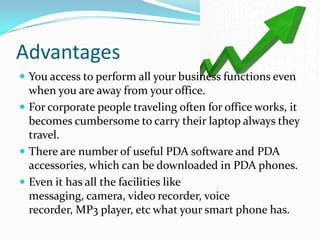PDAs
- 2. What do you understand by term P.D.A? PDA stands for Personal Digital Assistant.
- 3. It is a mobile device that functions as a personal information manager.
- 4. Also known as Palmtop ComputersWhat is P.D.A?PDA is personal information manager which often have the ability to connect to internet.
- 5. PDA has an Electronic Visual Display.
- 6. It also includes Web Browser.
- 7. PDAs can access internet using Wi-Fi.History of P.D.AThe term PDA was first used on January 7, 1992 by Apple Computer CEO John Sculley.
- 8. PDA was referred to as Apple Newton.
- 9. Nokia became the first company to first introduce PDA functionality in mobile phones in 1996.
- 10. The first mobile with PDA functionality was known as Nokia 9000 Communicator.
- 11. Today the vast majority of all PDAs are smart phones are available. Future of P.D.ATouch Screen
- 12. Memory Card
- 15. SynchronizationTouch ScreenTouch Screen PDAs such as the blackberry are used to facilitate data entry and navigation.
- 16. These âmulti-touch" displays allow for more sophisticated interfaces using various gestures entered with one or more fingers.
- 17. In Touch Screen the user interacts with the device by tapping the screen to select the button or issue the commands.Memory CardA memory card or flash card is an electronic flash memory data storage device used for storing digital information.Â
- 18. They are small, re-recordable, and they can retain data without power. Used in electronic devices such as digital cameras, mobile phones.
- 19. Some PDAs also have a USB port, mainly for USB flash drivers.Wired Connectivity While early PDAs connected to a user's personal computer via serial ports or another proprietary connection, many today connect via a USB cable.
- 20. PDAs are not typically able to connect to each other via USB.
- 21. Some early PDAs were able to connect to the Internet indirectly by means of an external modem connected via the PDA's serial port.Wireless Connectivity Most modern PDAs have Bluetooth a popular wireless protocol for mobile devices.  It's also possible to transfer files between PDAs that have Bluetooth.
- 22. Many modern PDAs have Wi-Fi wireless network connectivity, and can connect to Wi-Fi hotspots.
- 23. Most universal PDA keyboards use infrared technology because many older PDAs have it.  Infrared technology is low-cost and has the advantage of being allowed aboard aircraft.Synchronization Most PDAs can synchronize their data with applications on a user's personal computer. This eliminates the need for the user to update their data in two places.
- 24. Synchronization also prevents the loss of information stored on the device.
- 25. Most PDAs come with the ability to synchronize to a computer. This is done through synchronization software provided with the handheld, or sometime with the computer's operating system.Advantages You access to perform all your business functions even when you are away from your office.For corporate people traveling often for office works, it becomes cumbersome to carry their laptop always they travel.There are number of useful PDA software and PDA accessories, which can be downloaded in PDA phones. Even it has all the facilities like messaging, camera, video recorder, voice recorder, MP3 player, etc what your smart phone has.
- 26. Disadvantages With the problems such as if you phone hangs while listening to music via a headphone , and you do a alt+f4 shut down, the phone when later powered up will have no sound! because it digitally records that there was a headphone previously inserted.
- 27. Handwriting or digital keyboard really is slow and not as fast as the digital keypad.
- 28. Most PDAs have incompatible formats for transferring information between unlike brandsUses Educational uses:- Software companies have developed PDA programs to meet the instructional needs of educational institutions. Recreational uses:- Road rally enthusiasts can use PDAs to calculate distance, speed, and time. This information may be used for navigation, or the PDA's GPS functions can be used for navigation.













